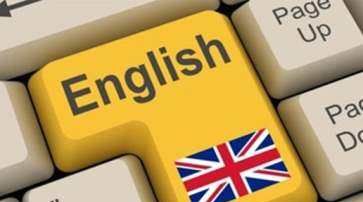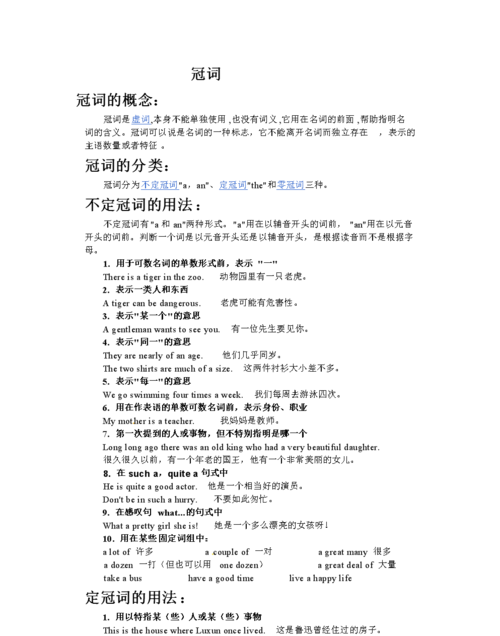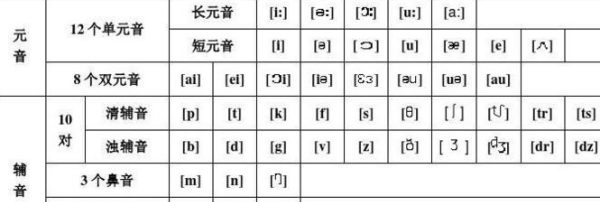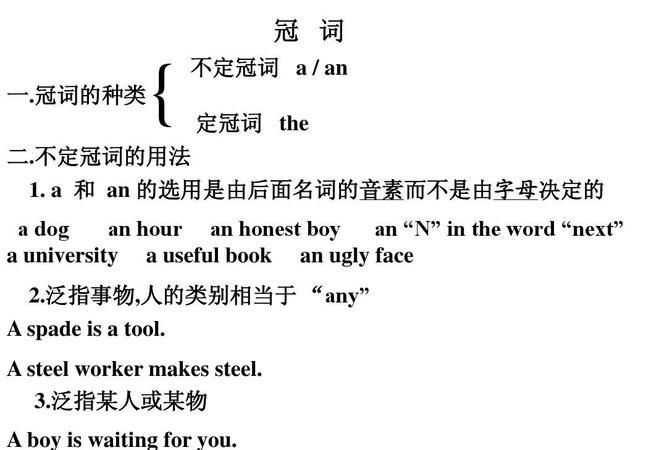本文目录
英语冠词的用法视频讲解
英语冠词用法讲解
导语:英语中的冠词怎么用才是正确的方式?下面是我整理的英语冠词用法讲解,欢迎参考!

冠词作为一种虚词,在英语中只能和名词一起使用。英语中的冠词分为不定冠词和定冠词。
1.不定冠词的用法
不定冠词有两个,a 和 an。a用在辅音开头的单词前面;an用于以元音开头的单词前。如:a book, an apple。
1) 不定冠词用在但数可数名词前表示“某一个”。如:
There is a policeman at the door.
门口有个警察。
2) 不定冠词用在单数可数名词之前,表示“任何,每个”。如:
A car must be insured.
汽车一定要上保险。
A soldier must obey orders.
军人必须服从命令。
3) 不定冠词用于头一次出现的单数名词之前。如:
There is a box in the room. The box is heavy.
房间里有个箱子。这个箱子很重。
4) 不定冠词和名词连用作表语或同位语,主要说明某个人或东西所属类别。如:
She is a teacher. 她是个老师。
We all thought him a suitable person for the job.
我们都认为他是适合做这个项目的人。
5) 定冠词用在价格、速度、比率等短语中。如:
six kilometers an hour 每小时60公里
3 times a day 每天三次
6) 不定冠词用在专有名词前。如:
He wants to buy a Kodak.他想买架柯达相机。
7)不定冠词用于某些固定短语中。如:
have a try 试一下take a break 休息一下 have a good time 玩得痛快
make a living 谋生as a matter of fact 事实上 in a word 总而言之
2. 定冠词的用法
1) 定冠词和名词连用,表示某个或某些特定的人或东西。如:
Mother carved the meat into slices.
妈妈把肉切成了片。
2) 定冠词用于可数名词前,表示一类人或东西。如:
The horse is a useful animal. 马是一种有用的动物。
3) 定冠词用于第二次出现的名词之前。如:
I got a letter yesterday. The letter was sent by e-mail.
我昨天接到了一封信。那信是电子邮件。
4) 定冠词用于有词组或者定语从句修饰的名词前。如:
He is investigating the cause of the fire.他正在调查这场大火的原因。
5) 定冠词用于某些名词或者形容词前,表示一类人,一个民族,阶级或阶层。如:
the chinese 中国人the rich 富人
the dead死者 the deaf 聋人
6) 定冠词用于指说话双方都知道的人或事。如:
Please close the door.请把门关上。
7) 定冠词用于世界上独一无二的事物前。如:
the sun 太阳 the earth 地球 the world 世界
8) 定冠词用于序数词前表示顺序。如:
the third group 第三组
9) 定冠词用于形容词和副词的最高级前面。如:
This is the most intersting book I have ever read. 这是我所读过的`书中最有趣的一本。
10)定冠词在play后和乐器连用
play the piano弹钢琴 play the flute吹长笛
11)定冠词与姓氏的复数形式连用,表示一家人。如:
The Blacks came to China in 1994.
布莱克一家是1994年来中国的。
12)定冠词的其他用法
the Changjiang River长江 the Red Sea 红海 (用于表示江河海洋的名词前)
the Taiwan Straits台湾海峡 the Gulf of Mexico墨西哥湾 (用于表示海峡海湾的名词前)
the Alps阿尔卑斯山 the Sahara Desert撒哈拉沙漠 (用于山脉沙漠的名词前)
the People’s Republic of China 中华人民共和国(用于国家名称)
the National Gallery国家美术馆the Military Museum 军事博物馆(用于公共建筑名前)
the State Council国务院 the Senate参议院 the House of Representatives 众议院 (用于机关、团体名词前)
the Geneva Agreement日内瓦协议 the Washington Post 华盛顿邮报 (用于报刊、条约之前)
3.不用冠词的情况
1) 表示独一无二的职务、身份前一般不用冠词。如:
Elizabeth II, Queen of England 英国女王伊丽莎白二世
He was elected chairmen of the committee.他当选为协会主席。
2) 表示球类、棋类的运动项目不加冠词。如:
play football 踢足球play chess下象棋
3) 在一日三餐名词前不用冠词。如:
have breakfast/lunch/supper 吃早饭/午饭/晚饭
4) 交通工具名词前不用冠词
by car坐汽车 by ship 坐船
by plane坐飞机on foot 步行
5) 在一些地点的名词,如:bed, church, school, hospital,home, work等。当人们去这些地方做在这些地方应该做的事时,不加冠词。
go home回家 go to school去上学 go to church去教堂祈祷
in hospital住院 go to work上班
注:如果在上述词组前面加上定冠词the,可以表示去这些场所做其他的事情。如:
He came to the school to speak to the headmaster.他来学校和校长谈话。
He went to the church to see the carvings.他去教堂看雕刻。
His mother is in hospital and he has been in the hospital to take care of her.
他妈妈生病住院了,他就一直在医院里面照顾她。
4.泛指概念的四种表达方式
1)不带the 的不可数名词可以表示泛指
I like music.我喜欢音乐。
2)不带the 的复数可数名词表示泛指。
Bananas are yellow.香蕉是黄色的。
3)“the+单数可数名词”可以表示泛指
The elephant is the largest land mammal.大象是陆地上最大的哺乳动物。
4)“不定冠词a/an+单数可数名词” 可以表示泛指。
A dog makes good pet.狗是很好的宠物。
;英语中零冠词的用法
定冠词是虚词,用在名词的前面,帮助指明名词的含义。区别于不定冠词,定冠词具有确定的意思,学好英语必须搞清楚它的用法。接下来我在这里给大家带来冠词的用法,我们一起来看看吧!
冠词的用法
一 不定冠词 a, an
1. a/an + 抽象名词 ,表具体化。 例:a success 一个成功的人/事
2.a/an + 时间名词 = every + 时间名词例:eat an egg a day
3. a/an = the same 例be of a size = be of the same size ; be of an age
4. 初次提到,用于介绍。例:She is a cook.
5. 固定词组 In a hurry , once upon a time , as a rule, many a time
二 定冠词 the
1. the + adj.表示一类人 。
the rich , the poor , the old , the young, the sick , the dead, the blind
2. the + 姓氏复数,表示夫妇俩或全家人。 the Greens
3. 用于被词语或从句修饰的名词前。 the + n + of … 结构
4. the + 发明物的单数名词. invent the wheel
5. the + 逢十的复数数词, 指某世纪的某年代。In the 1980s
6. the + 单位名词. pay by the hour / the pound
7. the + 身体部位 hit sb in the eye
8. the + 独一无二或上文提及的名词 ;the + 序数词 / 形容词最高级/西洋乐器 / 江河湖海山川群岛/ 说话双方都了解的人或物。
9. 固定用法。 The + 形容词比较级,the + 形容词比较级.
三 零冠词 (即 不用冠词、不填 或/ )
1 表职务头衔的名词作补语时 be made _/_ director.
2 “名词+ as “ 引导的让步状语从句中,作表语的名词被提置句首且前面无冠词。 Child as she is , she knows a lot of English.
3 季节、星期、月份、节假日、学科、棋类、球类、三餐及疾病颜色感官名词等抽象名词。
4 名词前已有物主代词或指示代词(this that these those ).
5 固定用法:turn writer ,no such thing, in public places , on foot , in use , watch TV, in bed, in space, in society,用于新闻标题,man / woman 指类别时。
不定冠词与冠词的固定搭配
1. have a cold 感冒 2. have a fever 发烧 3. have a try 尝试 4. have a talk 谈话 5. have/take a rest 休息 6. have/take a seat 就座 7. have/take a break 休息一下 8. have/take an interest in… 对……感兴趣 9. take a chance 冒险 10. make a promise 许诺 11. make a living 谋生 12. as a result 结果 13. -as a result of… 由于 14. all of a sudden 忽然 15. a waste of… 浪费 16. as a matter of fact 事实上 17. at a loss 亏本地; 困惑不解 18. at a time 一次; 每次; 在某时 19. in a word 总而言之 20. in a hurry 匆忙地 21. once in a while 偶尔; 有时 22. once upon a time 很久以前 23. in a way 在某种程度上; 有点; 十分激动 24. get in a word 插话 25. have a word with… 谈话 26. have a good time 过的开心; 玩的愉快 27. keep an eye on… 照看; 留意; 密切注视 28. a day or two 一两天 29. an hour and a half 一个半小时 30. on (the)one hand…on the other hand… 一方面; 另一方面 31. in the distance 在远处 32. by the way 顺便说 33. in the way 妨碍, 挡道 34. on the contrary 相反 35. on the whole 总体而言 36. take the place of… 代替 37. in the front of… 在……的前部 38. all over the world 全世界 39. at the end of..在……的尾声; 末端 40. in the end 最后 41. by the end of… 在……结束时; 在……之前 42. in the beginning 在开头, 在开端 43. at the beginning of… 在……的开头, 在……的开端 44. for the time being 当时 45. at the same time 同时 46. for the moment 当时 47. at the moment 此刻; 当前 48. the other day 不久前的一天 49. in the morning 在上午。 在早晨 50. the day before yesterday 前天 51. the day after tomorrow 后天 52. at first 起初; 首先 53. at least 至少 54. at most 至多; 最多 55. at present 目前; 当前 56. at work 工作中 57. in common 共同的; 共有的 58. in doubt 可怀疑的; 不肯定的 59. in spite of 尽管; 不管 60. in search of\for 寻找 寻求 61. in use 在使用中 62. in surprise 惊讶的 63. in place of 代替 64. in sight 看得见 65. in advance 提前 66. in public 公开地; 当众 67. in danger 在危险中 68. in favor of 喜欢; 支持 69. in charge of 管理; 负责 70. in case of 以防 71. in order 整齐; 井然有序; 状况良好 72. in time 及时 73. in need of 需求, 需要 74. in other words 换句话说 75. in trouble 在危险中 76. on sale 廉价出售; 打折促销 77. on fire 着火 78. on average 平均; 普通; 通常 79. on condition that.. 只要 80. on second thought 进一步考虑后; 仔细考虑后 81. out of sight 看不见 82. out of control 失控 83. out of work 事业 84. for instance 例如 85. for example 例如 86. for fear that 恐怕, 唯恐 87. by means of… 用……; 依靠……; 88. word comes that… 有消息称; 据说 89. come into being 开始形成 90. come into use 投入使用 91. come into effect 开始生效 92. pay attention to.. 注意 93. do good/harm to… 对……好; 对……有害 94. make fun of 取消 95. make room for… 给……腾地方 96. make use of 利用 97. make preparations 作准备 98. turn…into reality 把……变成现实 99. turn…into practice 把……投入实践 100. take part in 参加

英语冠词的用法总结
英语冠词如下:
拼写:从单词拼写角度看,英语中的冠词有3个:不定冠词a和an,定冠词the。
功能:从语法功能角度看,冠词有3种:不定冠词(a和an),定冠词(the)和零冠词(冠词的省略)。
从语音角度看,冠词应该有4个。跟不定冠词a+辅音音素而an+元音音素相同,定冠词the用在辅音音素开头的名词前读the[ðə],用在以元音音素开头的名词前读the[ði]。

注意事项
这里的元音音素和辅音音素跟前文凡是规则,皆有例外——规则的可数名词复数,真的规则吗?讲到的元音字母(aeiou)和辅音字母(其余21个字母)完全不是一个概念。用国际音标标注的20个元音(音素)和28个辅音(音素)。
英语冠词用法
1、不定冠词的用法不定冠词包括a/an,意思相当于one,很多情况下可以译成“一”、“每”,但是不像one一样强调数量,有时可以不译出。
2、定冠词的用法定冠词the主要对后面的名词起限定作用,“特指”是它的主要功能。
3、不用冠词(零冠词)的情况,物质名词表示泛指时不用冠词。抽象名词表示一种概念时不用冠词。表示国名、地名、人名、城市、街道、和首字母为Mount的山及大多数湖泊的专有名词前不用冠词。四季、月份、节假日、日期和星期等名词前不用冠词。

以上就是关于英语冠词的用法,英语冠词的用法视频讲解的全部内容,以及英语冠词的用法 的相关内容,希望能够帮到您。

